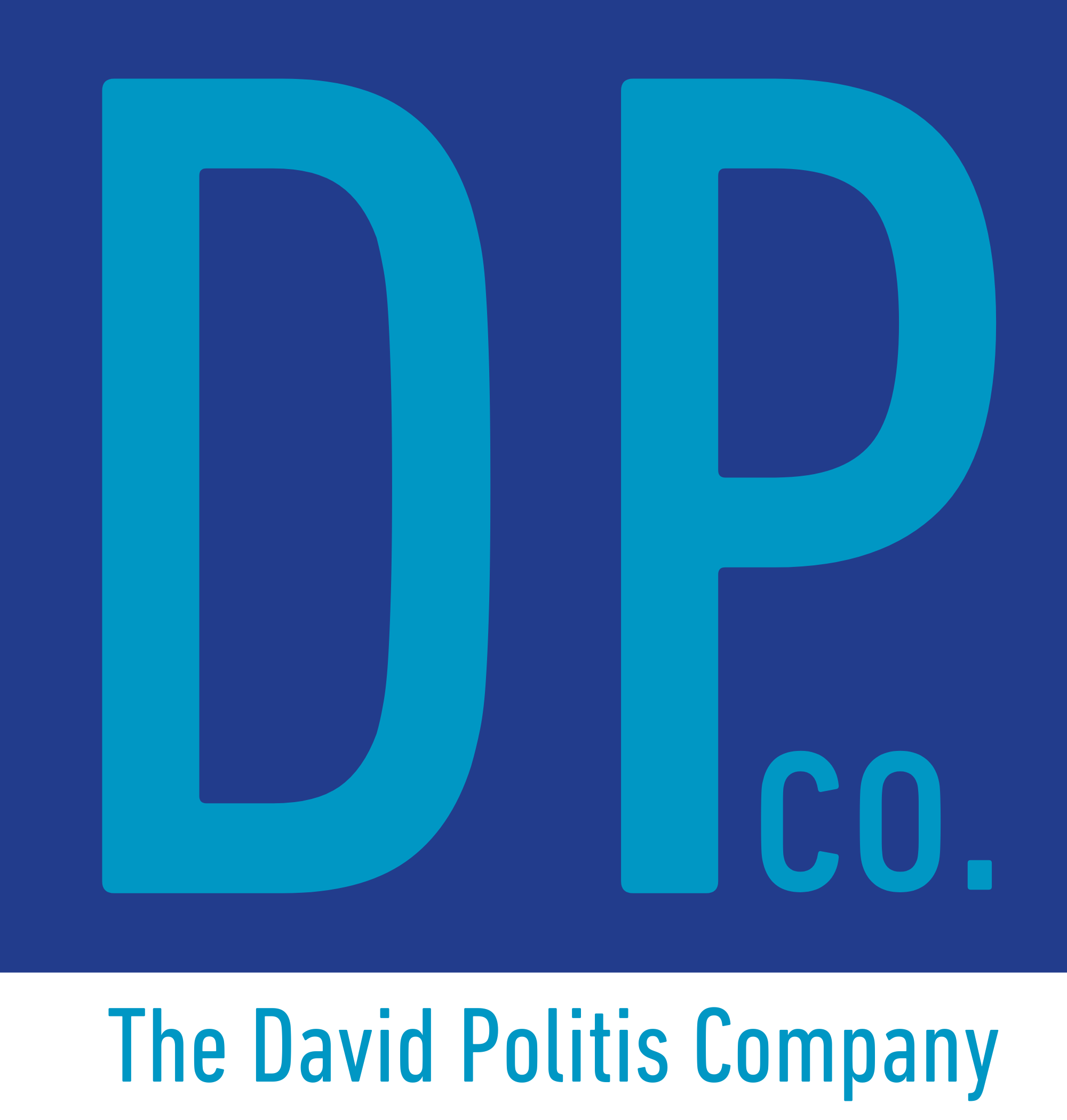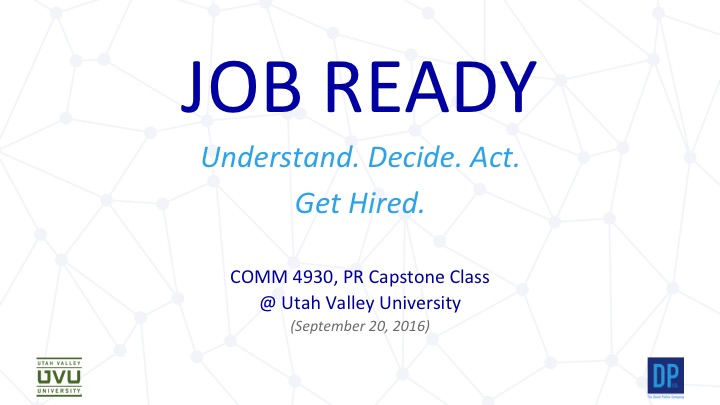20 Sep Landing Your First Professional Job: Nine Steps Every College or University Student Should take Now to Help you Land your Dream Job
For the second time in two days, I will share today what has become one of my favorite speeches:
JOB READY.
After reviewing thousands of resumes, interviewing hundreds of job candidates, and hiring dozens of paid interns and entry-level, I am now convinced that there are nine steps any student can take now to help them land their first professional job as they leave college. Here’s my list.
STEP #1: Attend the “Right” College or University.
Right off the bat I recognize that this first step may upset some administrators or professors. Sorry. But based upon my experiences, there are definitely right and wrong universities and colleges.
To me the wrong universities are those that ONLY focus on theories and book-learning and not on the practical application of what students learn in the classroom into the real-world. Some people might consider such paragons of higher learning Research Institutions. And to be clear, I am NOT saying that research in an academic setting is bad, because it is not. In fact, it can be extremely valuable.
However, my experience is that most employers are looking for two things when they hire students right out of college:
- Employees who can think for themselves, and
- Employees who have the knowledge to begin real-world work on Day One.
And institutions of higher learning that take this approach are what I consider to be right universities.
Case in point: I had an interesting experience several years back while visiting with the head of the Communications Department at a highly respected university. My premise was to find out why it was that the majority of intern and job candidates from her department were unprepared to enter the workforce because they had NOT completed practical, real-world communications work before applying to my firm. Her answer was both shocking and telling:
“That’s not what we do in our undergrad programs. That’s the purpose of graduate or post-graduate school.”
In other words, her department did NOT require students to work on actual assignments from real-world clients so they could apply what they had learned in class in a Live setting. The same was also true for student internships: they were NOT required before graduation. And in the case of PR students, these students were NOT required to work for the student paper or broadcast station.
I was appalled and yet suddenly clear-headed at the same time as I finally understood why 90 percent of her students were not a good fit for my company. It wasn’t the students fault; it was the university’s fault.
So … if you are presently enrolled in an undergraduate program at a university or college that DOES require you to participate in real-world assignments either in or outside of class, thank your lucky stars as you are definitely ahead of many of your peers. If, however, your school does not require such activities from you before you can graduate, you may want to consider transferring to another school that does.
Or you may want to craft your own out-of-class, real-world applications of your in-class learning. {For more on this subject, see Step #3 below.}
Then again, if you plan to go onto graduate school, it may not matter … much.
STEP #2: Get Involved.
To be clear, when I suggest that it’s important to Get Involved, I’m not referring to joining a sorority or fraternity — although that may not be a terrible idea for you (depending upon your intended career choice).
Rather I’m talking about getting involved with the Clubs, Societies, Associations or Student Organizations tied to your major. In the Public Relations world, that means joining the on-campus chapter of the Public Relations Student Society of America (PRSSA). For journalism, that means seeking out the student chapter of the Society for Professional Journalism.
At a minimum, you should join and participate in meetings and activities of said organizations. At a higher level, it means helping to run things for the organization, whether that means serving on committees or holding an elected or appointed office. Depending upon how your chapter or organization is setup, such participation will likely do four things for you:
- Create and build stronger relationships with your fellow students.
- Foster stronger relationships with faculty advisors and professors.
- Help you to reinforce what you’re learning in class.
- Build your portfolio of real-world activities.
each of which are critical components to making you more desirable than then next graduating student.
STEP #3: Do Real-World Stuff.
For all practical purposes, I have already covered this topic at a higher level in STEP #1 above.
However, from personal experience, when I left Brigham Young University, I had worked for the on-campus student newspaper for six months, and during that time I had published over 400 column inches of bylined stories. Additionally, I had worked in a part-time job for an organization that produced an annual on-campus conference, and I was the primary public relations/marketing liaison for several hundred local fraternal organizations.
And when I showed a prospective employer my portfolio containing my bylined articles, she exclaimed,
“You wrote all of these? In school?”
In fact, four weeks later that woman became my boss in a position I landed that did NOT exist when I first met her, in large part because I did Real-World stuff while I was still in school.
STEP #4: Capture Your Work.
The cliche asks
If someone does not see a tree fall in the woods, did it actually make a sound?
Similarly, some employers might wonder
If you didn’t save your work, did you actually do what you said you did?
Here is my advice: Save copies of every project you work on within your Major, both digital and physical copies.
Then as you begin preparing to leave school, you will have at your fingertips everything you need to take Step #5: Build Your Portfolio.
STEP #5(A): Build Your Portfolio.
Because you’ve already been making and keeping samples of your in- and out-of-class work, stuff like
- Reports,
- Papers,
- Research Studies,
- Videos,
- Photographs,
- Thank You Letters,
- Etc.
you will have the ability organize such items into a presentable, shareable and transportable format known as a portfolio.
The explosive growth of easy-to-use and free (or inexpensive) online publishing tools means that virtually anyone can create an digital, Web-based portfolio. And you should too.
At a minimum, you can build your own portfolio blog using services like WordPress or Blogspot or others. Of if you want to go a bit more upscale, you may choose to use Adobe’s MyPortfolio.com, where prices start at $9.99 per month.
In addition to creating a digital portfolio, I also recommend creating a physical version of your portfolio too. As a prospective employer, there are just times when I want to thumb-through a report or feel the weave of the paper or printed finish on a brochure or the heft of a 3D-Printed prototype. And that’s NOT possible with a digital portfolio.
So, “Yes,” have a portfolio, but create two versions:
- A Digital Portfolio, and
- A Physical Portfolio.
And make sure you bring your physical portfolio with you when you have face-to-face interviews.
STEP #5(B): Quality and Quantity.
While interviewing prospective employees and interns, I’ve had some candidates who have only shared one or two items with me. Their reasoning:
I only wanted to share my best work.
Such a statement is off-base for several reasons, especially for students preparing for graduation or for recent graduates.
Chances are you’re not experienced enough to know if it’s actually your best work or not. That is for the professional to decide, especially your prospective employer.
Given the fact that you were probably involved in your major for at least 2 years, I want to know what else you did profession-wise while you were at school. And if all you have to show me is 1 or 2 items from your schooling, that may be disconcerting. {Obviously, if your school requires students to work for 1—2 years on just one project, say a massive research study, then showcasing that (and perhaps that alone, may be okay.}
Personally, I’d rather you show me lots of work, and then have you say, “And I’m especially proud of this project.” In which case I’ll ask why you feel that way. At the same time, I’ll also be able to potentially see a breadth and depth of your capabilities.
In other words, employers want you to show them both Quality and Quantity.
STEP #6: LinkedIn.
There is no excuse for ANY college/university student in America to NOT have a LinkedIn account. Not one.
As of the writing of this article, there are over 450 million LinkedIn accounts worldwide. LinkedIn is now the de facto, professional social media network around the globe, and tens of thousands of executive recruiters, headhunters and human resources pros turn to it every business day to look for and review backgrounds of job candidates.
If you don’t have a LinkedIn account, STOP READING THIS ARTICLE AND GO CREATE YOUR OWN LinkedIn ACCOUNT NOW!
And if you’re not sure where to start, look it up on the Internet by doing a search for a topic like “What do I need in my LinkedIn Profile?” {FYI: I just conducted that exact search within Google and got back over 20 million results, so the info is out there.}
Then when you’re done creating a basic LinkedIn Profile, you and come back and finish reading this article.
STEP #7: A Social Warning.
I’m 99.99% sure that as a university student you have at least one social media account. Chances are you regularly use Snapchat and or Kik (or both), and probably Tinder (or something like it). And you probably have a Facebook account (even if you don’t use it very often), and you may have and use Instagram or Pinterest or a raft of other social platforms, 50 of which seem to pop-up every single day.
In spite of the fact that some of these accounts entice users by saying the things they share on these services disappear within a set period of time, the reality is that the moment you hit Send or Share, you have no idea where that video or photo or message will end up or who else it may be shared with.
Obviously that is one of the great things about the ability to Screengrab images and videos off of your phones and digital devices … you can share such files with other people, right?!?!?! And that’s the problem, or at least the potential problem.
If you haven’t done so lately, my advice is that you stop and go review every single item you have ever Posted or Shared on your Social Media accounts right away. And if there are ANY items you would be embarrassed to have your Granny or Pastor see, you need to delete those items ASAP.
NOT because you might be embarrassed (although that is a good reason), but because your potential employers will find those embarrassing photos, videos and messages. Trust me. That’s part of what HR Pros get paid to do — help their employers prevent potential problems BEFORE they can happen.
So …
- Those photos of you toking-up while in Cabo? Delete ’em.
- Those videos of you chugging directly from the kegger while dozens of drunken frat and sorority pals cheer you on? Dump ’em.
- Those rants you shared about what a pervy wanker your professor is? Yeah, get rid of them too.
STEP #8: The Perfect Resume.
Everyone graduating college senior should have a perfect resume. One single sheet of paper, single-or double-sided.
And it should be PERFECT. No misspellings. No punctuation errors. Flawless.
And this Perfect Resume should become your Master Resume. Then, every time you apply for a new position, you should start with your Master Resume and then modify it specifically to fit the position you are applying for at the company where the job is based.
To be clear, I am NOT suggesting that you lie or stretch the truth or fabricate information contained within this one-off version of your resume. NOT A GOOD IDEA!
However, many employers and recruiters now utilize principles common to Search Engine Optimization, the SEO tricks used in online marketing. So when these firms and recruiters get new resumes, they are scanned with software that looks for specific words, terms and phrases that are appropriate for the position they are trying to fill. And if your resume DOES NOT contain a minimal percentage of those key words, phrases and terms, it will be discarded without being seen or touched by an actual human being. Just like that.
In other words, you are OUT OF LUCK. Sorry, Charlie!
So … review any Job Postings or Listings carefully to look for likely key words, phrases and terms tied to that open position. And as long as your skills and experiences match-up with those key words, phrases and terms, then definitely incorporate them into that one-off version of your resume and submit it right away!
{BONUS TIP: This may seem obvious to some of you, but ALWAYS save your resume as a PDF before submitting it for an open position, especially if you are uploading your resume via the Internet. Taking this step minimizes the possibility that your resume might be altered, accidentally or on purpose.}
STEP #9: Perfection.
While Step #8 emphasized the need to create a “perfect” Master Resume, this step focuses on perfection within your other communications with prospective employers.
If you are asked to submit a Cover Letter with your resume, that Cover Letter MUST BE PERFECT: in spelling, in punctuation, in sentence structure, in grammar. All of it.
Because if it’s not perfect, you run the risk of getting your application tossed in the trash and not even getting past the first step.
If you are invited in a first interview with an organization, you must do everything in your power to find out BEFORE YOUR INTERVIEW who you will be meeting with and how they pronounce their first and last names.
Why? Because the second most damaging thing any job candidate can to is mispronounce an interviewer’s name! Bad Form.
Last of all, if you’re invited to a first interview with a firm, you should also do everything you can to learn all about that firm and its products, services, customers, partners, investors, etc. In other words, devour its Website (presuming it has one, which most companies do).
And then be prepared with prescient questions about the company and its products, services, customers, partners, investors, etc. to show the interviewer(s) that you did your homework before chatting with them. It’s another way of showcasing the concept that you may, in fact, be the Perfect Employee for them.
Conclusion.
In my opinion, any student who will implement these Nine Steps will dramatically increase the likelihood that they will land their dream job upon leaving their Alma Mater. And those who don’t will have to endure less than ideal job prospects.
# # #
I WELCOME YOUR THOUGHTS OR QUESTIONS ABOUT THIS ARTICLE AND HOPE YOU WILL SHARE THEM IN THE COMMENTS SECTION BELOW. THANKS.



No Comments